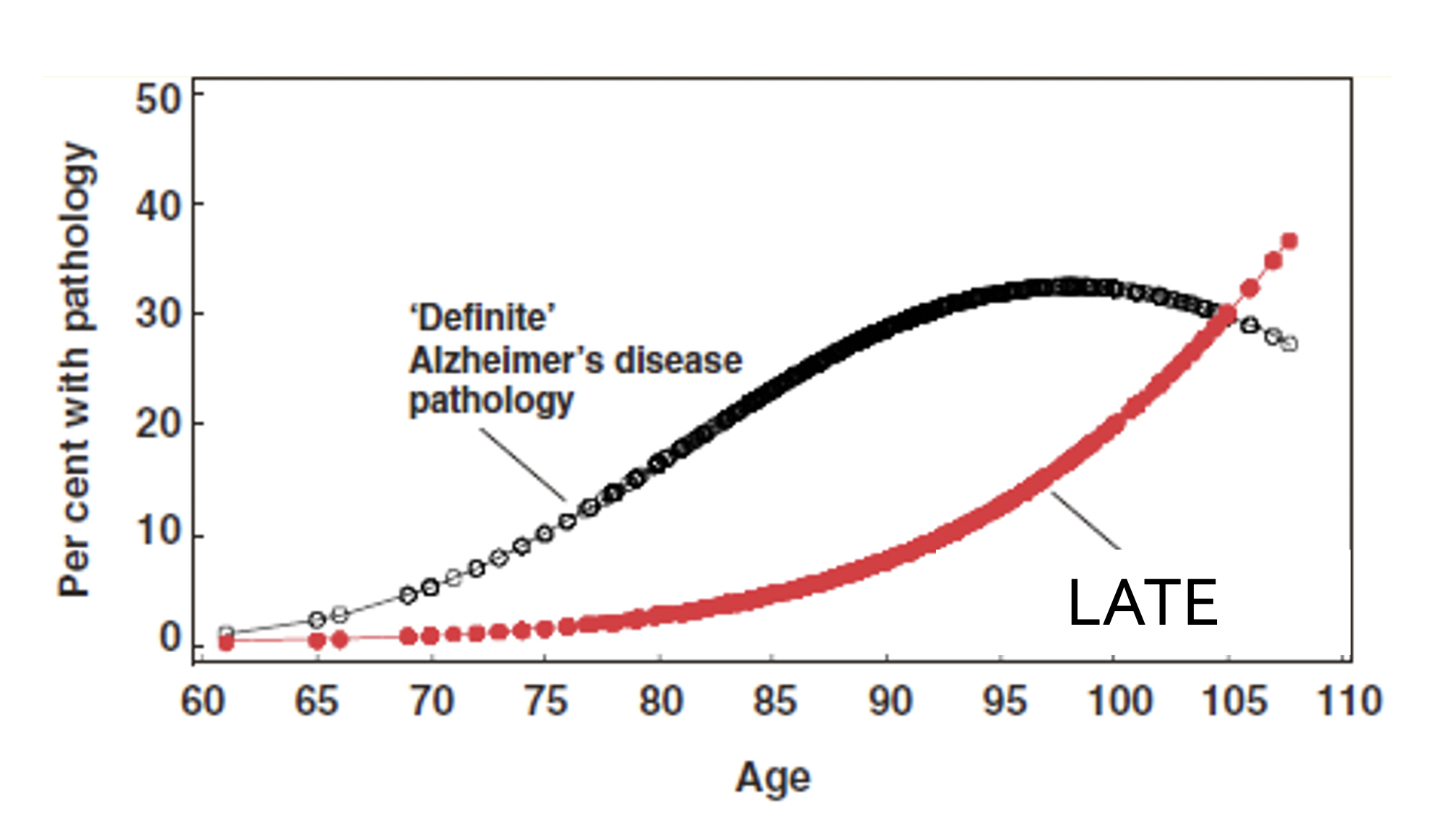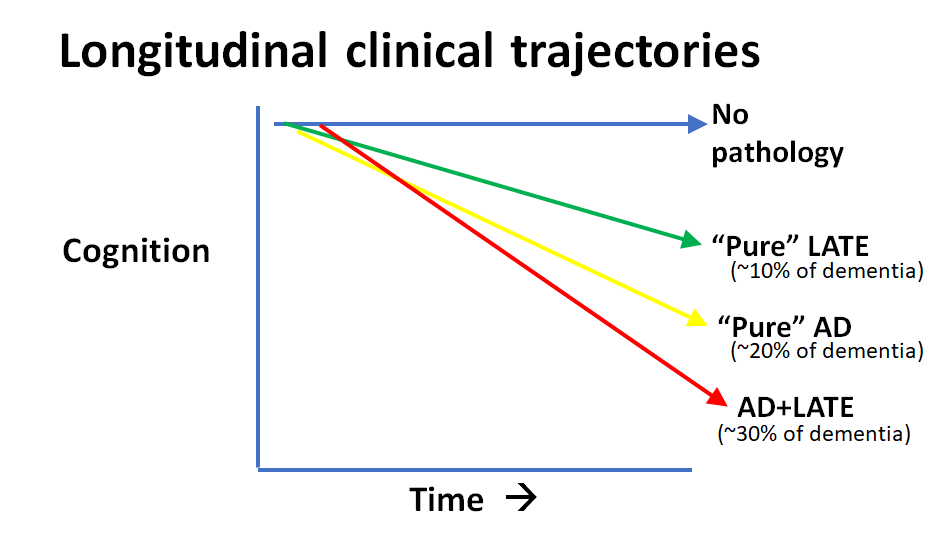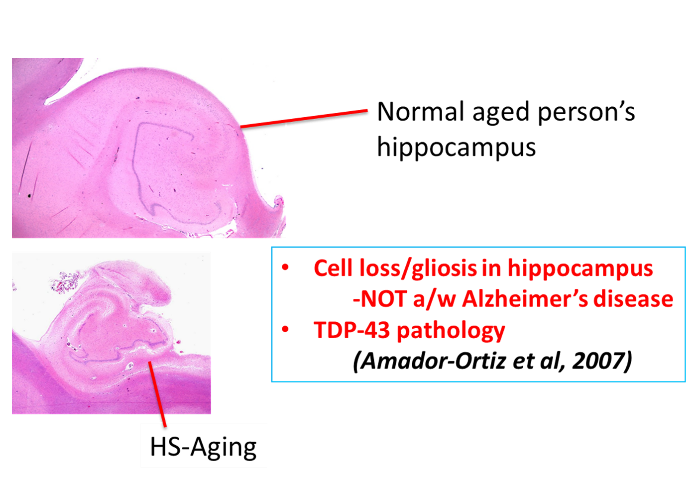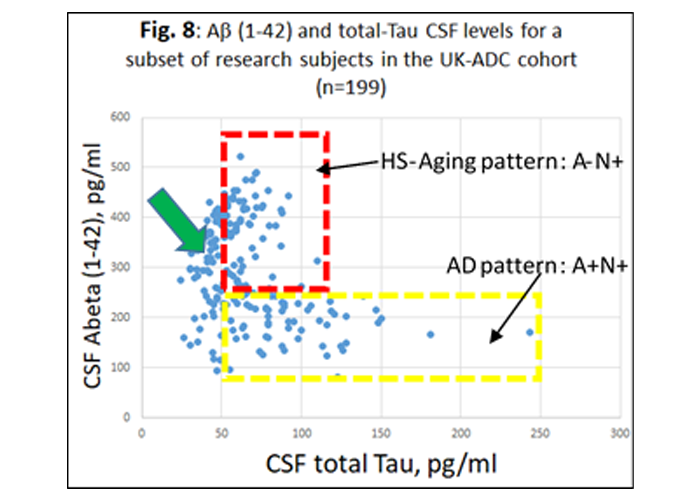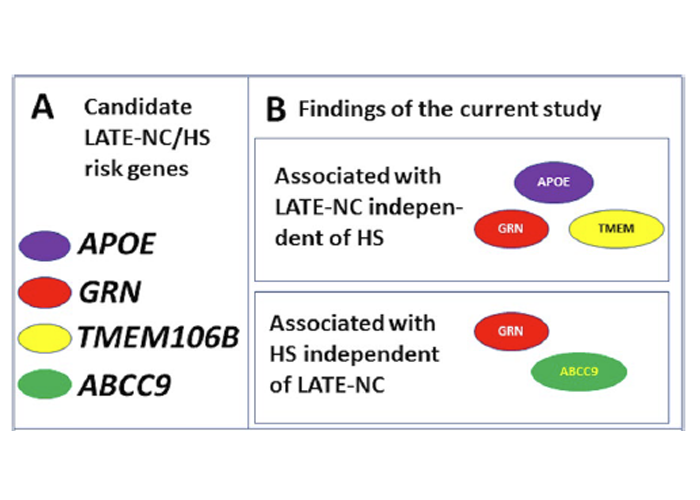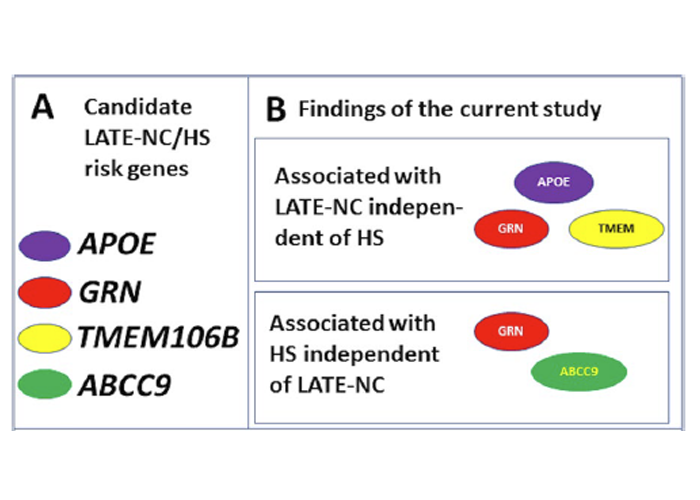LATE- Limbic-predominant age-related TDP-43 encephalopathy
LATE is one of the aging-related diseases that is caused by misfolded (“gloppy”) proteins deposited in brain cells.
More specifically, LATE describes a condition with impaired memory and thinking in advanced age, often culminating in a dementia clinical syndrome. The acronym LATE stands for Limbic-predominant Age-related TDP-43 Encephalopathy: “limbic” is related to the brain areas first involved, “age-related” and the name “LATE” itself refer to the onset of disease usually in persons aged 80 or older, “TDP-43” indicates the aberrant mis-folded protein (or proteinopathy) deposits in the brain that characterize LATE, and “encephalopathy” means illness of brain.
Discovery of LATE
After noticing that a large number of people who died in advanced age had symptoms of dementia without the signs of amyloid or tau pathology in their brain at autopsy (hallmarks of Alzheimer’s disease), researchers began looking for other explanations. Emerging research seemed to indicate the protein TDP-43 contributed to the phenomenon. In the Spring of 2019 an international group of experts led by Dr. Peter Nelson, PhD of UK SBCoA characterized LATE. That discovery was recognized as one of the top science stories of 2019 by Discover magazine. It was also named the number one advancement in 2019 in the field of neurodegenerative neuropathology.
Signs and Symptoms
The symptoms of LATE are similar to those of Alzheimer’s disease, but a person with LATE pathology may have slower progression of dementia compared with those who only have Alzheimer’s disease pathology. A person who has both LATE and Alzheimer’s may advance much faster in their disease progression.
Symptoms may include:
- Memory loss that disrupts daily life
- Poor judgment
- Wandering and/or getting lost
- Misplacing things
- Difficulty completing tasks
- Difficulty with personal hygiene
- Challenges in planning or solving problems
- Mood and personality changes
An Alzheimer’s mimic?
LATE symptoms often mimic the symptoms of Alzheimer’s disease. LATE often occurs in brains where other pathologic changes are happening, such as Alzheimer’s disease and cerebrovascular disease. A person may have more than one dementia pathology. Mimicry in nature is common.
Can you identify the mimics in these pictures?



Diagnosis
At present LATE can only be diagnosed with 100% certainty at autopsy, however physicians are often able to diagnose it in life by looking at a person’s clinical history, testing their memory and thinking, getting some basis blood tests performed and a brain scan including an MRI and possibly a PET scan or spinal fluid test. This testing can help rule out other causes for the memory loss. Interpretation of such testing that might lead to a diagnosis should be made by a healthcare professional with experience in the diagnosis of LATE and other causes of dementia.
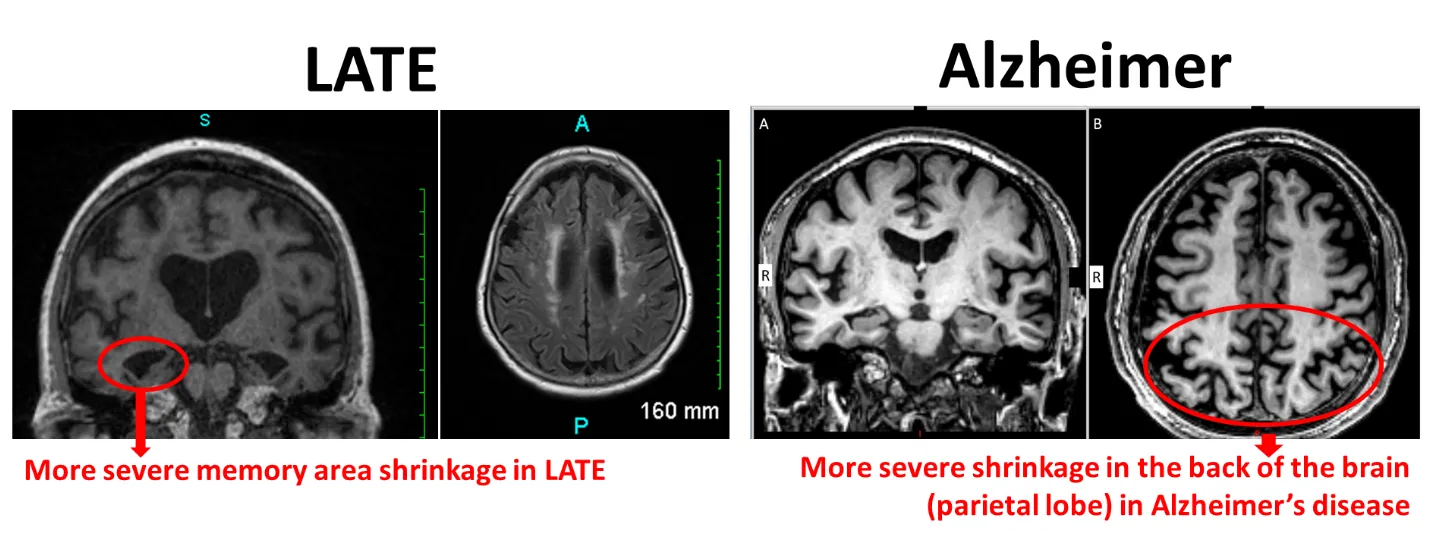
As LATE is a relatively recent discovery, few medical professionals have as of yet acquired the skills to accurately diagnose this condition. Make sure you have a qualified and experienced healthcare professional on your team!
Diagnosing LATE in the setting of AD can be problematic for even the most experienced clinician as we have no definitive test for LATE at present. Stay tuned for more discoveries that may allow such diagnosis as our understanding of LATE rapidly moves forward.
Prevalence
LATE is a very common condition: autopsy studies around the world indicate that LATE is present in the brains of about one-third of people over 85. LATE becomes increasingly prevalent every year in advanced old age. The older you get the greater your risk for LATE can be. If you live long enough, LATE may even be more common than AD. Approximately one-half of persons with Alzheimer's disease pathology also have LATE pathology.
LATE Risk Factors
A major risk factor for LATE is age. LATE typically affects persons older than 75 years of age. Other major known risk factors for LATE are genetic variations in the TMEM106B, GRN, APOE, ABCC9, KCNMB2, and WWOX genes.
Treatment
So far there is no treatment that has been proven to stop or slow the progression of LATE. However, the University of Kentucky Sanders-Brown Center on Aging currently has the first and only clinical trial for this condition. Study details for the SMArT-HS trial can be found at https://clinicaltrials.gov/study/NCT04120766?term=jicha&intr=Nicorandil&rank=1 or call us at 1-859-323-5550. This study is US FDA approved (IND 147152) and has allowed us to bring a medicine into the US to try and treat this condition that is not available anywhere else in the US for the treatment of this disease. It remains uncertain if the experimental medicine can help, but its use is supported by many scientific publications and discoveries. At this time the study is closed for enrollment.
More Information About LATE
Articles
Nov. 28, 2025- A Different Type of Dementia Is Changing What’s Known About Cognitive Decline On its own, LATE dementia is less severe than Alzheimer’s, but in combination, it makes Alzheimer’s symptoms worse, scientists say. This New York Times article by Pam Belluck shares about LATE and the first clinical trial for it being done at the Sanders-Brown Center on Aging.
Nov. 19, 2020 – ‘Behind the Blue’: Dr. Peter Nelson Discusses UK’s Leading Efforts on Alzheimer’s and Dementia Research
On this episode of “Behind the Blue,” UK Public Relations and Strategic Communications’ Carl Nathe talks with Dr. Peter Nelson, of the University of Kentucky’s Sanders-Brown Center on Aging. Dr. Nelson discusses the work of the Sanders-Brown Center on Aging, the strategies involved in working with such a complex set of diseases, the personal experience that drives his efforts in this research, and more.
Aug. 25, 2020 – UK’s Sanders-Brown, Penn Researchers Provide Insights into Newly Characterized Form of Dementia
Working with their colleagues at the University of Pennsylvania, researchers at the University of Kentucky have found that they can differentiate between subtypes of dementia inducing brain disease.
Jul. 30, 2020 – UKNow: Important Dementia Studies Continuing at UK Despite Ongoing COVID-19 Pandemic
The COVID-19 pandemic brought many things to a screeching halt and continues to impact our daily lives. However, important research at the University of Kentucky’s Sanders-Brown Center on Aging (SBCoA) is continuing under extreme caution and deep dedication.
Jan. 16, 2020 – UKNow: UK Researcher Makes ‘Top Science Stories of 2019’ List by Discover Magazine
An international group of experts led by Dr. Peter Nelson, a neuropathologist at the University of Kentucky Sanders-Brown Center on Aging, is being recognized as one of the top science stories of 2019 by Discover magazine. Back in the Spring of 2019, Nelson and the group characterized a different form of dementia that is now called LATE.
May 1, 2019 – UKNow: When is Alzheimer’s Not Alzheimer’s? Researchers Characterize a Different Form of Dementia
A group of international researchers co-chaired by Dr. Peter Nelson and Dr. Nina Silverberg set out to define diagnostic criteria and other guidelines for advancing future research into this newly-named dementia, called LATE.
June 29, 2011 – UKNow: Nelson Appointed to NIH Study Section
Dr. Peter Nelson of the University of Kentucky Sanders-Brown Center on Aging has been appointed as a regular member of the Chronic Dysfunction and Integrative Neurodegeneration (CDIN) study section for the National Institutes of Health (NIH).
Articles
Nov. 28, 2025- A Different Type of Dementia Is Changing What’s Known About Cognitive Decline On its own, LATE dementia is less severe than Alzheimer’s, but in combination, it makes Alzheimer’s symptoms worse, scientists say. This New York Times article by Pam Belluck shares about LATE and the first clinical trial for it being done at the Sanders-Brown Center on Aging.
Nov. 19, 2020 – ‘Behind the Blue’: Dr. Peter Nelson Discusses UK’s Leading Efforts on Alzheimer’s and Dementia Research
On this episode of “Behind the Blue,” UK Public Relations and Strategic Communications’ Carl Nathe talks with Dr. Peter Nelson, of the University of Kentucky’s Sanders-Brown Center on Aging. Dr. Nelson discusses the work of the Sanders-Brown Center on Aging, the strategies involved in working with such a complex set of diseases, the personal experience that drives his efforts in this research, and more.
Aug. 25, 2020 – UK’s Sanders-Brown, Penn Researchers Provide Insights into Newly Characterized Form of Dementia
Working with their colleagues at the University of Pennsylvania, researchers at the University of Kentucky have found that they can differentiate between subtypes of dementia inducing brain disease.
Jul. 30, 2020 – UKNow: Important Dementia Studies Continuing at UK Despite Ongoing COVID-19 Pandemic
The COVID-19 pandemic brought many things to a screeching halt and continues to impact our daily lives. However, important research at the University of Kentucky’s Sanders-Brown Center on Aging (SBCoA) is continuing under extreme caution and deep dedication.
Jan. 16, 2020 – UKNow: UK Researcher Makes ‘Top Science Stories of 2019’ List by Discover Magazine
An international group of experts led by Dr. Peter Nelson, a neuropathologist at the University of Kentucky Sanders-Brown Center on Aging, is being recognized as one of the top science stories of 2019 by Discover magazine. Back in the Spring of 2019, Nelson and the group characterized a different form of dementia that is now called LATE.
May 1, 2019 – UKNow: When is Alzheimer’s Not Alzheimer’s? Researchers Characterize a Different Form of Dementia
A group of international researchers co-chaired by Dr. Peter Nelson and Dr. Nina Silverberg set out to define diagnostic criteria and other guidelines for advancing future research into this newly-named dementia, called LATE.
June 29, 2011 – UKNow: Nelson Appointed to NIH Study Section
Dr. Peter Nelson of the University of Kentucky Sanders-Brown Center on Aging has been appointed as a regular member of the Chronic Dysfunction and Integrative Neurodegeneration (CDIN) study section for the National Institutes of Health (NIH).
Peter T. Nelson, MD, PhD
Room 311
Sanders-Brown Center on Aging
800 S. Limestone St.
Lexington, KY
(859) 218-3862 (office)
(859) 323-2866 (fax)

